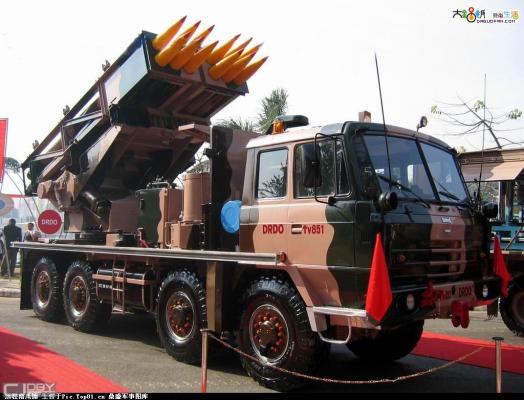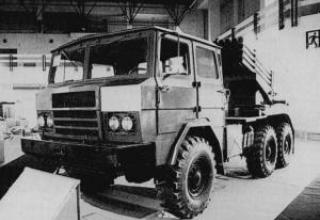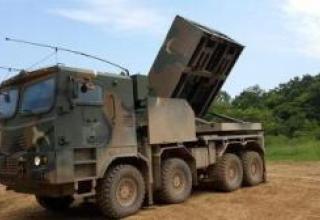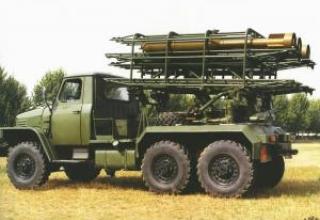The Indian all-weather multiple launch rocket system (MLRS) "Pinaka" is designed to engage manpower, light armored and armored vehicles, missile launchers, destruction of command posts, communication centers and military industrial infrastructure facilities, remote installation of anti-tank and anti-personnel minefields. The system is designed to perform combat missions, including in mountainous terrain, using the tactics of rapid strikes with a change of firing positions.
The development of the Pinaka MRLS sketch design began in 1983, in accordance with the terms of reference formulated by the Ministry of Defence of India for a new generation of multiple rocket launchers for the Indian Army. In December 1986, the Ministry of Defence of India allocated Rs. 264 million for the development of this system. The development cooperation included Armament Research & Development Establishment (ARDE), Combat Vehicle Research & Development Establishment (CVRDE), High Energy Material Research Laboratory (HEMRL) and Electronics & Radar Development Establishment (ERDE). The development of Pinaka's CDDCs has been very difficult due to the lack of backlogs by Indian firms in a number of key technologies and has been very late in terms of timing. The first combat vehicle sample was not ready until 1994, and full-scale testing of the system began in June 1997. During the first phase of testing, the maximum range of 37 km was achieved with a circular probable deviation of 4% from the range. In October 1997, the project modernisation programme was adopted, which was aimed at eliminating significant shortcomings in the design of the system. The main objectives of the modernization program, calculated until December 2000, were to achieve the design range and accuracy. The second stage of testing started in July 1998. During these tests the flight range of 40 km and accuracy of 2-3% were achieved. Totally 256 missiles were used on these two stages.
Military tests began in February 1999. The combat application of the system took place in summer 1999 during the Indo-Pakistani conflict in the Kargil sector (northern part of Jammu and Kashmir states of India). According to Indian military experts, the Pinaka RSF showed its best performance during 73 days of combat.
In September 1999, the system was adopted by the Indian Army, although not all requirements of the terms of reference were met. In particular, a cluster combat unit with various types of combat equipment was not tested, and the time for reloading the combat vehicle was significantly exceeded. The first regiment of Pinaka MLRS entered service in February 2000 and included three batteries of six combat vehicles each, as well as support vehicles. On March 29, 2006 the Indian army signed contracts worth Rs200mln (45mln USD) to produce 40 Pinaka systems each with TATA Power's Advanced Material Division and Larsen & Tubro's Heavy Engineering Division. The first of these systems went into service in late 2006. The new systems are intended for replacement of 122-mm RSZO "Grad" of Russian production, which are planned to be phased out.
The development of the system continues in the direction of increasing the range and accuracy of firing, development of new types of combat equipment. It was reported about successful testing of the rocket projectile developed jointly with the company "Israel Military Industries" and equipped with the trajectory correction system.
The Defence Research and Development Organization (DRDO) of the Indian Ministry of Defence reported on projects to develop an improved version of the Pinaka Mk.2 MLRS as well as new types of ammunition. The target range is expected to increase from 40 km to 60 km. An upgraded version of the Pinaka Mk.2 was presented at the Defexpo-India exhibition in 2012 (see photo). The system continues to be improved, in particular, for firing RS at a range of 120,000 m.
Composition:
Composition of Pinaka RESO:
- combat vehicle (BM);
- 214mm unguided rockets (NURS);
- transport and charging machine (TZM) (see photo);
- transport vehicle (TM) (see photo);
- Command and Staff Machine (CSCM).
The combat vehicle, as well as TZM and TM, are placed on a modified cross-country vehicle Tatra-815 Colos WN (wheel arrangement 8x8), licensed by Bharat Earth Movers Ltd (BEML). The artillery part, located at the rear of the BM, is two bags of six tubular rails. The artillery part consists of an electromechanical drive for pointing at an elevation angle and angle of place. The combat vehicle is autorizonized by means of electro-hydraulic jacks.
In front of the BM there is a sealed cabin for a crew of five people. The cockpit is equipped with a filter-ventilation unit, which provides protection of the crew from destructive factors of nuclear, chemical and bacteriological weapons. The system of centralized regulation of tire pressure provides the combat vehicle with increased cross-country ability on different types of soils. The maximum travel speed is 80km/h, the vehicle can climb up to 30°. The combat vehicle is provided with modern fully automated fire control and fire-fighting systems as well as IR night vision devices. The time of full salvo is 44s. The time of recharging the BM with the TZM is 15 minutes, currently works are underway to reduce the recharging time to 4 minutes.
The battery consists of six combat vehicles, six vehicle-charging vehicles, three transport vehicles and a command and control vehicle with an automated positioning system, fire control system (LCS) and weather station DIGICORA.
Battery combat vehicles may operate in the following modes:
- Automatic mode. KSHM LSR calculates the flight mission data and transmits the NURS guidance package and fuse data commands to BM LSR. PM status and control commands are displayed on the operator's display in the combat vehicle cabin.
- Stand-alone mode. In this mode, each combat vehicle operates independently. Calculation of the flight task, pointing and starting is performed by the operator with the help of the BM CLC.
- Remote control. Aiming and launching is carried out by the operator with the remote control from a distance of up to 200m.
- Manual control. It is used at failure of the BM CLC and provides fully manual control of the combat vehicle.
Upgraded versions of the Pinaka fire control system can be targeted by various Indian Army radars and thermal imaging detection systems, as well as by Israeli-made Searcher-1, Searcher-2 and Heron unmanned aerial vehicles. The area of destruction of the battery in full volley (6 BM) is 1000x800m.
For firing the NURS 214 mm caliber with mixed solid propellant rocket engines are used, which can be equipped with the following types of head units (HP):
- blasted;
- shrapnel-flash with ready to hit elements (HF weight 100 kg).
- incendiary;
- cassette, equipped with anti-tank mines;
- cassette, equipped with cumulated shrapnel warheads;
- shooter.
Antitank warheads and mines are equipped with a composition based on NMX (octogen) and are capable of penetrating armour with a thickness of 100-150 mm. The length of the NURS is 4950mm and weighs 276kg. The minimum projectile range is 10km, the maximum projectile range is 40km. Circular probable deviation is 1-2% of the range. The temperature of combat application is from -20° to +55°C.
In 2005, the developers announced the creation of a new jet projectile with an increased range up to 120 km and a mass of the head end up to 250 kg. The new projectiles have an increased flight speed (up to M=4.7 at an altitude of 40 km) and are equipped with a dual-mode jet engine, which provides rapid acceleration of the projectile at the initial site of the trajectory. The length of the new projectile is 7.2m. Entry into service of the new sample is planned from 2012.
Characteristics:
| Number of guides, pcs. | 12 |
| Caliber, mm | 214 |
| NURS Length, mm | 4950 |
| Start weight NURS, kg | 276 |
| Weight of the head end, kg | 100 |
| Range of fire, km: - minimum - maximum |
10 40 |
| Angle of elevation, deg: - minimum - maximum |
0 +55 |
| Angle of horizontal fire, deg. | ±90 |
| Time to move from camping to combat, min. | 3 |
| Time of transfer from combat to camping, min. | 2 |
| Pointing speed, deg/s | 5 |
| Full salvo time, s | 44 |
Testing:
In West Germany, 108 launchers (120 missiles) for Pershing-2 missiles were deployed on three missile operating bases. In peacetime, all missiles and equipment were usually in fixed hangars. It was planned to move them to the wooded areas of Bavaria, where the missile batteries took up launch positions and prepared for combat missions. The flight time of Pershing-2 to the objects located in the center of the European part of the USSR was only 8-10 minutes, which made them a very dangerous weapon of the first strike.
Like the Soviet medium-range missiles, the Pershing-2 fell under the DSMD Treaty. All 120 deployed and 127 non-deployed missiles in the US territory were eliminated by the middle of 1991.
There is information about the use of the Pershing-2 control and guidance system in the Hera target missile. It was assembled from the second and third stages of the Minuteman-2 intercontinental missiles removed from combat duty. The U.S. used to take this vehicle off the destructible Pershing-2 missiles and store it. The Pentagon division, the Ballistic Missile Defense Organization, actively uses Hera as a simulator for its two missile defense systems: THAAD and Patriot PAC-3. The Russian military classifies Hera as a medium-range ground-based ballistic missile (BNB). The creation, production and deployment of such weapons is categorically prohibited under the DSM Treaty.
Sources:
- URL: 214mm PINAKA MBRL /http://bharat-rakshak.com/
- URL: Images 214mm PINAKA MBRL /http://bharat-rakshak.com/
- Гуров С.В. "Реактивные системы залпового огня" .-Тула.: "Пересвет", 2006- 432с.
- URL: Development of Multi Barrel Rocket Launcher System (Pinaka)
- URL: http://www.militaryphotos.net
- URL: http://www.redstar.ru/index.php/news-menu/ino-military-menu/finlyandiya/item/1269-proizvodstvo-raket-dlya-rszo












